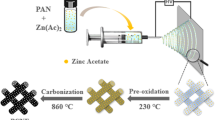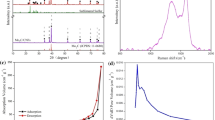Abstract
For advanced energy storage devices, high-performing and stable lithium–sulfur (Li–S) battery is one of the most prominent alternatives. However, one of the major challenges for Li–S battery development is to overcome the rapid capacity decay arising from polysulfide dissolution. Herein, a self-standing carbon nanofiber (CNF) matt derived from polyimide is fabricated by a simple, yet versatile electrospinning technique. An optimized CNF matt is introduced between sulfur cathode and separator that act as an interlayer, providing continuous pathway for electronic and ionic interactions, which accommodates volume expansion and impedes dissolution of the polysulfide intermediate species. The resulting sulfur-based Li–S cell delivers high specific initial discharge capacity of 1474 mAh g−1 and retains capacity of 1014 mAh g−1 even after 100 cycles at 1 A g−1 current density. Further, the cell demonstrated good reversible capacity for 500 cycles as well as excellent rate capability. This study demonstrates that CNF matt provides significant improvement in capturing polysulfides intermediate species from electrolyte that can extend the life span of sulfur cathode for long-standing applications.






Similar content being viewed by others
References
Yang Y, Zheng G, Cui Y (2013) Nanostructured sulfur cathodes. Chem Soc Rev 42:3018–3032. https://doi.org/10.1039/c2cs35256g
Zhang SS (2013) Liquid electrolyte lithium/sulfur battery: fundamental chemistry, problems, and solutions. J Power Sources 231:153–162. https://doi.org/10.1016/j.jpowsour.2012.12.102
Manthiram A, Fu Y, Chung S, Zu C, Su Y (2014) Rechargeable lithium–sulfur batteries. Chem Rev 114:11751–11787. https://doi.org/10.1021/cr500062v
Manthiram A, Fu Y, Su Y (2013) Challenges and prospects of lithium–sulfur batteries. Acc Chem Res 46:1125–1134. https://doi.org/10.1021/ar300179v
Ji L, Rao M, Aloni S, Wang L, Cairns EJ, Zhang Y (2011) Porous carbon nanofiber–sulfur composite electrodes for lithium/sulfur cells. Energy Environ Sci 4:5053–5059. https://doi.org/10.1039/c1ee02256c
Chen T, Zhang Z, Cheng B, Chen R, Hu Y, Ma L, Zhu G, Liu J, Jin Z (2017) Self-templated formation of interlaced carbon nanotubes threaded hollow Co3S4 nanoboxes for high-rate and heat-resistant lithium–sulfur batteries. J Am Chem Soc 139:12710–12715. https://doi.org/10.1021/jacs.7b06973
Ma L, Lin H, Zhang W, Zhao P, Zhu G, Hu Y, Chen R, Tie Z, Liu J, Jin Z (2018) Nitrogen-doped carbon nanotube forests planted on cobalt nanoflowers as polysulfide mediator for ultralow self-discharge and high areal-capacity lithium–sulfur batteries. Nano Lett 18:7949–7954. https://doi.org/10.1021/acs.nanolett.8b03906
Ma L, Zhu G, Zhang W, Zhao P, Hu Y, Wang Y, Wang L, Chen R, Chen T, Tie Z, Liu J, Jin Z (2018) Three-dimensional spongy framework as superlyophilic, strongly absorbing, and electrocatalytic polysulfide reservoir layer for high-rate and long-cycling lithium–sulfur batteries. Nano Res 12:6436–6446. https://doi.org/10.1007/s12274-018-2168-8
Jeong YC, Kim JH, Nam S, Park CR, Yang SJ (2018) Rational design of nanostructured functional interlayer/separator for advanced Li–S batteries. Adv Funct Mater 28:1707411. https://doi.org/10.1002/adfm.201707411
Deng N, Kang W, Liu Y, Ju J, Wu D, Li L, Hassan BS, Cheng B (2016) A review on separators for lithium–sulfur battery: progress and prospects. J Power Sources 331:132–155. https://doi.org/10.1016/j.jpowsour.2016.09.044
Su YS, Manthiram A (2012) Lithium–sulphur batteries with a microporous carbon paper as a bifunctional interlayer. Nat Commun. https://doi.org/10.1038/ncomms2163
Zu C, Su Y, Fu Y, Manthiram A (2013) Improved lithium–sulfur cells with a treated carbon paper interlayer. Phys Chem Chem Phys 15:2291–2297. https://doi.org/10.1039/c2cp43394j
Zhang K, Qin F, Fang J, Li Q, Jia M, Lai Y et al (2014) Nickel foam as interlayer to improve the performance of lithium–sulfur battery. J Solid State Electrochem 18:1025–1029. https://doi.org/10.1007/s10008-0132351-5
Huang J, Xu Z, Abouali S, Garakani MA, Kim J (2016) Porous graphene oxide/carbon nanotube hybrid films as interlayer for lithium–sulfur batteries. Carbon 99:624–632. https://doi.org/10.1016/j.carbon.2015.12.081
Huang JQ, Zhang B, Xu ZL, Abouali S, Garakani MA, Huang J et al (2015) Novel interlayer made from Fe3C/carbon nanofiber webs for high performance lithium–sulfur batteries. J Power Sources 285:43–50. https://doi.org/10.1016/j.jpowsour.2015.02.140
Wu F, Li W, Guan L, Ye Y, Qian J, Yang X et al (2015) A polypyrrole supported carbon paper acting as a polysulfide trap for lithium–sulfur batteries. RSC Adv 5:94479–94485. https://doi.org/10.1039/C5RA19348F
Xie Q, Zhao P, Wu S, Zhang Y (2017) Flexible carbon@graphene composite cloth for advanced lithium–sulfur batteries and supercapacitors with enhanced energy storage capability. J Mater Sci 52:13478–13489. https://doi.org/10.1007/s10853-017-1451-5
Chen T, Cheng B, Zhu G, Chen R, Hu Y, Ma L, Lv H, Wang Y, Liang J, Tie Z, Jin Z, Liu J (2017) Highly efficient retention of polysulfides in “sea urchin”-like carbon nanotube/nanopolyhedra superstructures as cathode material for ultralong-life lithium–sulfur batteries. Nano Lett 17:437–444. https://doi.org/10.1021/acs.nanolett.6b04433
Ma L, Zhang W, Wang L, Hu Y, Zhu G, Wang Y, Chen R, Chen T, Tie Z, Liu J, Jin Z (2018) Strong capillarity, chemisorption, and electrocatalytic capability of crisscrossed nanostraws enabled flexible, high-rate, and long-cycling lithium–sulfur batteries. ACS Nano 12:4868–4876. https://doi.org/10.1021/acsnano.8b01763
Park J, Yu BC, Park JS, Choi JW, Kim C, Sung YE et al (2017) Tungsten disulfide catalysts supported on a carbon cloth interlayer for high performance Li–S battery. Adv Energy Mater 7:1602567. https://doi.org/10.1002/aenm.201602567
Zhao T, Ye Y, Peng X, Divitini G, Kim HK, Lao CY et al (2016) Advanced lithium–sulfur batteries enabled by a bio-inspired polysulfide adsorptive brush. Adv Funct Mater 26:8418–8426. https://doi.org/10.1002/adfm.201604069
Sun W, Ou X, Yue X, Yang Y, Wang Z, Rooney D et al (2016) A simply effective double-coating cathode with MnO2 nanosheets/graphene as functionalized interlayer for high performance lithium–sulfur batteries. Electrochim Acta 207:198–206. https://doi.org/10.1016/j.electacta.2016.04.135
Zhang Z, Li Q, Jiang S, Zhang K, Lai Y, Li J (2015) Sulfur encapsulated in a TiO2-anchored hollow carbon nanofiber hybrid nanostructure for lithium–sulfur batteries. Chem A Eur J 21:1343–1349. https://doi.org/10.1002/chem.201404686
Lao M, Zhao G, Li X, Chen Y, Dou SX, Sun W (2017) Homogeneous sulfur–cobalt sulfide nanocomposites as lithium–sulfur battery cathodes with enhanced reaction kinetics. ACS Appl Energy Mater. https://doi.org/10.1021/acsaem.7b00049
Zhang Z, Wang G, Lai Y, Li J, Zhang Z, Chen W (2015) Nitrogen doped porous hollow carbon sphere-decorated separators for advanced lithium e sulfur batteries. J Power Sources 300:157–163. https://doi.org/10.1016/j.jpowsour.2015.09.067
Ai W, Zhou W, Du Z, Chen Y, Sun Z, Wu C et al (2017) Nitrogen and phosphorus codoped hierarchically porous carbon as an efficient sulfur host for Li–S batteries. Energy Storage Mater 6:112–118. https://doi.org/10.1016/j.ensm.2016.10.008
Zhou X, Liao Q, Tang J, Bai T, Chen F, Yang J (2016) A high-level N-doped porous carbon nanowire modified separator for long-life lithium sulfur batteries. J Electroanal Chem 768:55–61. https://doi.org/10.1016/j.jelechem.2016.02.037
Dong Z, Kennedy SJ, Wu Y (2011) Electrospinning materials for energy related applications and devices. J Power Sources 196:4886–4904. https://doi.org/10.1016/jpowsour.2011.01.090
Liu Q, Zhu J, Zhang L, Qiu Y (2018) Recent advances in energy materials by electrospinning. Renew Sustain Energy Rev 81:1825–1858. https://doi.org/10.1016/j.rser.2017.05.281
Peng YT, Lo CT (2015) Electrospun porous carbon nanofibers as lithium ion battery anodes. J Solid State Electrochem. https://doi.org/10.1007/s10008-015-2976-7
Singhal R, Chung S, Manthiram A, Kalra V (2015) A free-standing carbon nanofiber interlayer for high-performance lithium–sulfur batteries. J Mater Chem A Mater Energy Sustain. 3:4530–4538. https://doi.org/10.1039/C4TA06511E
Peng Y, Zhang Y, Wang Y, Shen X, Wang F, Li H, Hwang BJ, Zhao J (2017) Directly coating a multifunctional interlayer on the cathode via electrospinning for advanced lithium–sulfur batteries. ACS Appl Mater Interfaces 9:29804–29811. https://doi.org/10.1021/acsami.7b08804
Lee DK, Ahn CW, Jeon HJ (2017) Web-structured graphitic carbon fiber felt as an interlayer for rechargeable lithium–sulfur batteries with highly improved cycling performance. J Power Sources 360:559–568. https://doi.org/10.1016/j.jpowsour.2017.06.048
Liu Z, Liu B, Guo P, Shang X, Lv M, Liu D, He D (2018) Enhanced electrochemical kinetics in lithium–sulfur batteries by using carbon nanofibers/manganese dioxide composite as a bifunctional coating on sulfur cathode. Electrochim Acta 269:180–187. https://doi.org/10.1016/j.electacta.2018.02.160
Wu K, Hu Y, Shen Z, Chen R, He X, Cheng Z, Pan P (2018) Highly efficient and green fabrication of a modified C nanofiber interlayer for high-performance Li–S batteries. J Mater Chem A 6:2693–2699. https://doi.org/10.1039/c7ta09641k
Tu S, Chen X, Zhao X, Cheng M, Xiong P, He Y, Zhang Q, Xu Y (2018) A polysulfide-immobilizing polymer retards the shuttling of polysulfide intermediates in lithium–sulfur batteries. Adv Mater 30:1804581. https://doi.org/10.1002/adma.201804581
Kim C, Choi YO, Lee WJ, Yang KS (2004) Supercapacitor performances of activated carbon fiber webs prepared by electrospinning of PMDA-ODA poly(amic acid) solutions. Electrochim Acta 50:883–887. https://doi.org/10.1016/j.electacta.2004.02.072
Deng H, Yao L, Huang Q, Su Q, Zhang J, Du G (2016) Highly improved electrochemical performance of Li–S batteries with heavily nitrogen-doped three-dimensional porous graphene interlayers. Mater Res Bull 84:218–224. https://doi.org/10.1016/j.materresbull.2016.08.014
Xuyen NT, Ra EJ, Geng HZ, Kim KK, An KH, Lee YH (2007) Enhancement of conductivity by diameter control of polyimide-based electrospun carbon nanofibers. J Phys Chem B. 111:11350–11353. https://doi.org/10.1021/jp075541q
Kim S, Jang KS, Choi HD, Choi SH, Kwon SJ, Kim ID et al (2013) Porous polyimide membranes prepared by wet phase inversion for use in low dielectric applications. Int J Mol Sci 14:8698–8707. https://doi.org/10.3390/ijms14058698
Cao L, An P, Xu Z, Huang J (2016) Performance evaluation of electrospun polyimide non-woven separators for high power lithium-ion batteries. J Electroanal Chem 767:34–39. https://doi.org/10.1016/j.jelechem.2016.01.041
Gu PY, Zhao Y, Xie J, Ali NB, Nie L, Xu ZJ et al (2016) Improving the performance of lithium–sulfur batteries by employing polyimide particles as hosting matrixes. ACS Appl Mater Interfaces 8(11):7464–7470. https://doi.org/10.1021/acsami.6b01118
Zhang Z, Wang G, Lai Y, Li J (2016) A freestanding hollow carbon nano fiber/reduced graphene oxide interlayer for high-performance lithium–sulfur batteries. J Alloys Compd 663:501–506. https://doi.org/10.1016/j.jallcom.2015.11.120
Yang Y, Sun W, Zhang J, Yue X, Wang Z, Sun K et al (2016) High rate and stable cycling of lithium–sulfur batteries with carbon fiber cloth interlayer. Electrochim Acta 209:691–699. https://doi.org/10.1016/j.electacta.2016.05.092
Yuan X, Liu B, Hou H, Zeinu K, He Y, Yang X et al (2017) Facile synthesis of mesoporous graphene platelets with in situ nitrogen and sulfur doping for lithium–sulfur batteries. RSC Adv 7:22567–22577. https://doi.org/10.1039/C7RA01946G
Zhang Z, Lai Y, Zhang Z, Li J (2015) A functional carbon layer-coated separator for high performance lithium sulfur batteries. Solid State Ion 278:166–171. https://doi.org/10.1016/j.ssi.2015.06.018
Moy D, Narayanan SR (2017) Mixed conduction membranes suppress the polysulfide shuttle in lithium–sulfur batteries. J Electrochem Soc 164:560–566. https://doi.org/10.1149/2.0181704jes
Song J, Xu T, Gordin ML, Zhu P, Lv D, Jiang Y et al (2014) Nitrogen doped mesoporous carbon promoted chemical adsorption of sulfur and fabrication of high-areal-capacity sulfur cathode with exceptional cycling stability for lithium–sulfur batteries. Adv Funct Mater 24:1243–1250. https://doi.org/10.1002/adfm.201302631
Chai L, Wang J, Wang H, Zhang L, Yu W, Mai L (2015) Porous carbonized graphene-embedded fungus film as an interlayer for superior Li–S batteries. Nano Energy 17:224–232. https://doi.org/10.1016/j.nanoen.2015.09.001
Kaewruang S, Chiochan P, Phattharasupakun N, Suktha P, Kongpatpanich K, Maihom T et al (2017) Strong adsorption of lithium polysulfides on ethylenediamine-functionalized carbon fiber paper interlayer providing excellent capacity retention of lithium–sulfur batteries. Carbon 123:492–501. https://doi.org/10.1016/j.carbon.2017.07.096
Singh KP, Song MY, Yu JS (2014) Iodine-treated heteroatom-doped carbon: conductivity driven electrocatalytic activity. J Mater Chem A 2:18115–18124. https://doi.org/10.1039/C4TA03706E
Hou TZ, Chen X, Peng HJ, Huang JQ, Li BQ, Zhang Q et al (2016) Design principles for heteroatom-doped nanocarbon to achieve strong anchoring of polysulfides for lithium–sulfur batteries. Small 12:3283–3291. https://doi.org/10.1002/smll.201600809
Acknowledgements
The funding from ARCI-Technical Research Centre {Ref. No. AI/1/65/ARCI/2014 (c)} through Department of Science and Technology (DST), India, is highly acknowledged. The authors are thankful to Dr. Atul S. Deshpande for BET and M. Ramakrishna for TEM measurements.
Author information
Authors and Affiliations
Corresponding author
Additional information
Publisher's Note
Springer Nature remains neutral with regard to jurisdictional claims in published maps and institutional affiliations.
Electronic supplementary material
Below is the link to the electronic supplementary material.
Rights and permissions
About this article
Cite this article
Pakki, T., Mohan, E.H., Hebalkar, N.Y. et al. Flexible and free-standing carbon nanofiber matt derived from electrospun polyimide as an effective interlayer for high-performance lithium–sulfur batteries. J Mater Sci 54, 9075–9087 (2019). https://doi.org/10.1007/s10853-019-03534-4
Received:
Accepted:
Published:
Issue Date:
DOI: https://doi.org/10.1007/s10853-019-03534-4




